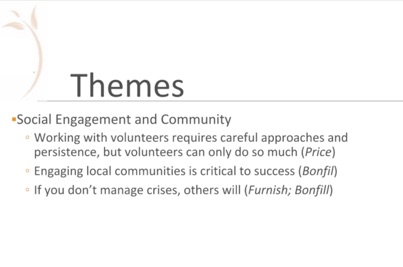

Lessons learnt
‣ A nature area which has been declared “protected” is not necessarily protected for real.
‣ Monetisation of nature does not protect it.
‣ Severe underestimation of the key differences between common law and civil law legal systems.
‣ Choose your fights, choices are hard but inevitable. Ranging values is painful but needed.
‣ Then keep focus.
‣ Do not allow the profiteurs ruin your project.
‣ Commitment to long-term protection is critical. Identifying tools for long-term legal protection is
essential. Get legal support from the start, unsettled legal issues can kill your project.
‣ Learn from Nature: Start small, Identify limits of growth early.
‣ Do not stay isolated, share your experiences.
‣ However in some cases it is better to be alone than in bad company.
‣ It’s about working with live beings, they do not obey market or institutional rules.
‣ Solutions are usually found in other areas of life.
‣ Some fights are not worth fighting.
‣ Every crisis is an opportunity.
‣ You will not change others, do not waste energy, impose limits.
‣ Interlinkages are more important than separate parts.
‣ Be prepared for everyone to use your achievements, shamelessly.
‣ A private nature protection project is usually a personal project.
‣ All private projects are different, each is unique. It’s a reservoir for high diversity of land and nature
protection techniques.
‣ In private nature protection diversity counts more than uniformity.
‣ Tell the difference between “private” and “privately” protected areas. The role of private protected
areas are greatly underestimated, while privately protected areas are well supported.
‣ Private land protection projects fall between cracks with funding and other support arrangements, it is
difficult to access compensation and carbon offsets markets, no tax benefits and little logistic support.
‣ Protection by obtaining special conservation status does not necessarily provides the best protection.
Maintaining private property might be a more effective protection in some cases, at present private
property is better protected then publicly owned nature.
‣ You will need to be polymathic and multifunctional.
‣ To your questions you should look for your own answers.
‣ You need to live in your project, but not be part of it: you can’t assess something you are an integral
part of.
‣ You can change attitude by changing behaviour. But it takes a lot of time.
‣ Time and commitment are more important than the volume of protected land.virtual cha
‣ Those who live digital lives and chaos will not understand you.
‣ Nature always knows best.
‣ Nature’s intelligence has proven more helpful then human, and especially artificial, intelligence.
‣ Nature needs time. Do not add to the general increase of entropy.
‣ Nature-rescue projects are more effective when they are not advertised or exposed to public domain.
‣ Learn from Nature: tell the difference between necessity and wish.
‣ Learn from Nature: make your project grow like a tree.
‣ Learn from Nature: do not take shortcuts.
‣ Sometimes the ecosystem just does not respond, you have to accept it.
‣ Nature needs our thinking and ethics, not necessarily our money.
‣ Not everything that seemed good in the office turned out to be fit for life.
‣ Projects developed quickly disappear quickly.
‣ Institutional environmental theories change faster and faster.
‣ Periodic pauses for effectiveness evaluation are needed, using your own evaluation criteria and
indicators. A question to yourself: “Are we likely to regret this decision later ?” helps.
‣“Capsule” or “island” (= not too much interaction with immediate surrounding environment), or
heterotopia type nature protection projects are feasible and can work.
‣ Do not build access to your project: it contributes to access by visitors (= tourists), erosion,
loss of biodiversity, etc.
‣ Term “environment” might be misleading for this type of projects, it allows protection of human
environment, not necessarily of Nature. Sometimes they have conflicting demands and are different
battles.
‣ Beware the environmental amnesia and the extinction of the experience of nature in the new and
coming generations.
‣ Measurements kill.
‣ Adopt adaptive management.
‣ International information exchange has proven more helpful than local cooperation.
‣ Putting aside national differences is an asset, cultural differences are different from national ones.
‣ Working with local communities is often challenging for private projects (see SER below). Main
problematic issue: change of land use.
‣ Principle of “common but differentiated responsibility” does not always work for nature protection,
individual responsibility seems to be more effective.
‣ Relations with the scientific world have been ambiguous, did not help the ecosystem, some scientific
research has put in danger the nature protected by the project, mainly by publicly advertising access
to it without any consultation.
‣ Ecology is a discipline of crisis: you have to act from the start, without knowing everything, ethics shall
take over science.
‣ One time observations are more valuable than peer-reviewed tests, some science just does not work in
the field.
‣ Seminars, conferences, etc. are dominated by scientists and consultants, very little representation of
landowners of protected land.
‣ Use the terminology and vocabulary adapted to your project and you are comfortable with.
‣ Nature has been a much better guide than science.
‣ If facts of your everyday experience do not fit the theory, dismiss the theory, not the facts.
‣ Conservation-oriented legal instruments turned out to be occasional obstacles to restoration.
‣ The project never participates in large reforestation campaigns - they are not professional and no one
knows what happens to the trees in future, lots of them are dead.
‣ There is not need to focus on conservation if there is not too much left to conserve in the area.
‣ Reforestation: use of professional planters, not volunteers, is very important for success.
‣ Planting in wet areas did not work too well.
‣ Understand and evaluate the extent of the damage first.
‣ Where feasible, privilege natural regrowth by protection.
‣ Wetlands can recover quickly.
‣ It’s too late to eliminate invasive species - can only limit their spread.
‣ Quality of seedlings is essential, almost all seedlings of bad quality died.
‣ Land use is the key factor for restoration.
‣ No need to identify reference ecosystems or sites - climate and other anthropogenically induced
changes will never permit matching them.
‣ The concept of baseline has not worked (baselines crisis) - Land Degradation Neutrality (LDN) seems to
be a more appropriate concept.
‣ You have to find new allies when the obvious natural ones like insects, worms, bacteria, fungi have
been exterminated.
‣ Ecosystems are different worldwide, changes are the same - restoration works with change.
‣ Use of glyphosate for invasives’ control is questionable (kills the soil microbiota,) but no other effective
alternatives available.
‣ Use of anti-parasites and antibiotics for horses and cattle severely alters the soil essential microbiota,
in particular large, like worms or mushrooms.
‣ Start monitoring the rebound of the from the very beginning, the project missed some
opportunities.
‣ Concepts like “biodiversity” are not necessarily imperative: high biodiversity corresponds to transitional
states. If they have to go, they should go without suffering.
‣ Help the strong, not the weak.
‣ Do not build access roads.
‣ Keep for future useful lessons learned through the “click” culture, well after they are forgotten.
We regret :
✓ Having allowed one local staff to have some cows in the
project for some time. A couple of cows can be as damaging
as 2000 cows in terms of management.
✓ Building a road for the ecosystem restoration project which,
as a side effect, facilitated access to an unprotected glacier
and an unprotected area of a national park.
-
✓Having accepted an intern from CIEP
who turned out to be from mining industry.
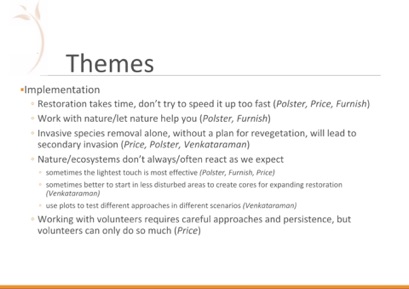
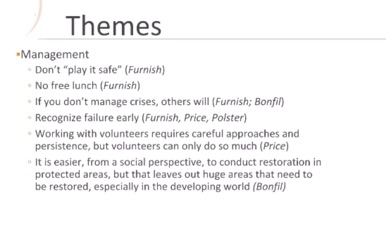
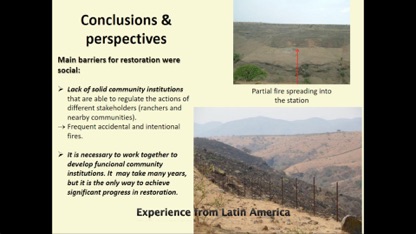
Helpful conclusions of a webinar on lessons learnt, Society of Ecological Restoration :

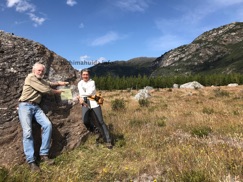
V.I.Vernadsky:
“The merit is in the method: abandon all hypotheses and philosophy, focus on empirical generalisations and conclusions, .. ponder over the previous theories and hypotheses.”
From an old schoolbook on agriculture:
“What is not environmentally friendly, what is harmful for nature, that is, the natural complex as a whole, for the land, river, forest, cannot be economical, but rather absurd, immoral and criminal.”
SER, some lessons from :
The US: tried to restore a water creek, did not work until realised that the sediments came from roads, crossing the creek.
Another case: seeding of grass and legumes prevented the establishment of trees. 40 years later there were still no trees. In addition, as the grass was seeded need roads to stabilise sides, it provided food for wildlife and put them at risk, lots of wildlife killed. So the “rough and loose” restoration concept was developed, creating environment for first colonisers, no seeding.
Canada: buckthorn removal: shall be removed when blooming, and - it’s quite challenging to work with volunteers.
Mexico: a scientific organisation linked to a University under the agreement with the community and its leaders started a project of restoration of overgrazed land. The leaders changed and a conflict linked to loss of pasture started. Finally, the communities set fire to the restoration facilities, and to the plantations.
India: removal of an invasive plant. What scientists did not tell was that secondary invasives will be more of a problem than the plant removed. The advice is: do small plots before starting, for new initiatives use only ecological parameters, collect and spread local seeds - just help nature.
